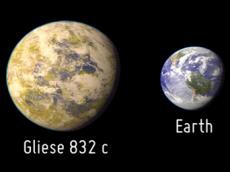|
|
TODAY.AZ / Weird / Interesting
One of the most Earth-like planets yet discovered
30 June 2014 [11:26] - TODAY.AZ
 Sci-News.com is reporting that astronomers at the University of New South Wales have discovered an Earth-like planet just 16 light-years away. The planet, dubbed Gliese 832c, is orbiting a red dwarf star half the mass and radius of our own sun. Gliese 832c has an orbital period of about 35 days, and a mass more than five times that of Earth's. More importantly, however, Gliese 832c is orbiting within the habitable zone of the red dwarf, and receives the same average stellar energy as Earth does from the Sun, Sci-News.com reports.
Sci-News.com is reporting that astronomers at the University of New South Wales have discovered an Earth-like planet just 16 light-years away. The planet, dubbed Gliese 832c, is orbiting a red dwarf star half the mass and radius of our own sun. Gliese 832c has an orbital period of about 35 days, and a mass more than five times that of Earth's. More importantly, however, Gliese 832c is orbiting within the habitable zone of the red dwarf, and receives the same average stellar energy as Earth does from the Sun, Sci-News.com reports.Gliese 832c's mass means it likely has a far denser atmosphere than Earth does, which could make the planet's weather hot and volatile. If this is the case, the planet might be more like a super-Venus than a super-Earth. "If the planet has a similar atmosphere to Earth it may be possible for life to survive, although seasonal shifts would be extreme," the University of South Wales' Professor Chris Tinney said. Even so, Gliese 832c is one of the most Earth-like planets we've ever encountered.
"[Gliese 832c is] one of the top three most Earth-like planets according to the [Earth Similarity Index] (i.e., with respect to Earth's stellar flux and mass) and the closest one to Earth of all three — a prime object for follow-up observations," writes Abel Mendez Torres on the Planetary Habitability Lab's blog. "It's just a stone's throw from Earth in the cosmic scheme of things," adds Space.com's Mike Wall.
/Theverge.Com/
URL: http://www.today.az/news/interesting/134905.html
 Print version
Print version
Views: 3143
Connect with us. Get latest news and updates.
See Also
- 19 February 2025 [22:20]
Visa and Mastercard can return to Russia, but with restrictions - 05 February 2025 [19:41]
Japan plans to negotiate with Trump to increase LNG imports from United States - 23 January 2025 [23:20]
Dubai once again named cleanest city in the world - 06 December 2024 [22:20]
Are scented candles harmful to health? - 23 November 2024 [14:11]
Magnitude 4.5 earthquake hits Azerbaijan's Lachin - 20 November 2024 [23:30]
Launch vehicle with prototype of Starship made its sixth test flight - 27 October 2024 [09:00]
Fuel prices expected to rise in Sweden - 24 October 2024 [19:14]
Turkiye strikes terror targets in Iraq and Syria - 23 October 2024 [23:46]
Kazakhstan supplied almost entire volume of oil planned for 2024 to Germany in 9 months - 23 October 2024 [22:17]
Taiwan reported passage of Chinese Navy aircraft carrier near island
Most Popular
 Algeria expels 12 French diplomats amid rising diplomatic tensions
Algeria expels 12 French diplomats amid rising diplomatic tensions
 Azerbaijan discusses co-op & regional stability with Syrian Transitional Government
Azerbaijan discusses co-op & regional stability with Syrian Transitional Government
 Macron's Monday: scandal again, sent again
Macron's Monday: scandal again, sent again
 Azerbaijan, Qatar explore prospects for expanded healthcare cooperation
Azerbaijan, Qatar explore prospects for expanded healthcare cooperation
 Robert Kocharyan's promotion of ethnic hatred against Azerbaijanis exposed
Robert Kocharyan's promotion of ethnic hatred against Azerbaijanis exposed
 Accused French spy Martin Ryan claims his ties were ‘personal’
Accused French spy Martin Ryan claims his ties were ‘personal’
 President approves partnership agreement on digital economy within OTS members
President approves partnership agreement on digital economy within OTS members
